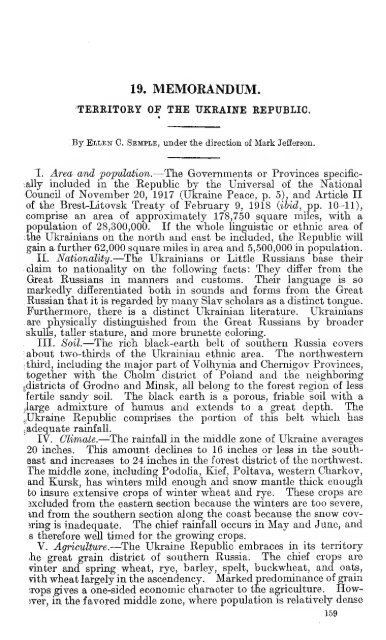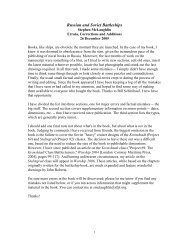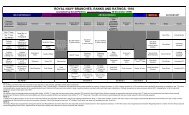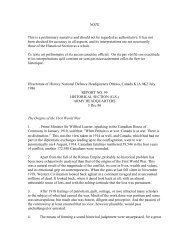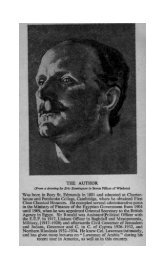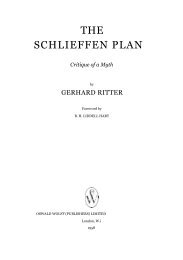- Page 1 and 2:
*;a4?ffi!i!^ m MN .^>- !*^ ::^^m; '
- Page 3 and 4:
D 614.B6A2*" ""'""^"y ^""^'^y '''°
- Page 5:
CONFIDENTIAL FOB OFFICIAL USE ONLY
- Page 9:
CONFIDENTIAL FOE OFFICIAL USE ONLY
- Page 13 and 14:
PROCEEDINGS OF THE BREST-LITOVSK CO
- Page 15 and 16:
AUSTEO-HUNGARIAN REPLY TO KBYLENKO.
- Page 17 and 18:
FIKST TELKGEAM FROM KRYLENKO. 11 in
- Page 19 and 20:
SESSIONS OF 3 AND 4 DECEMBEE. 13 II
- Page 21 and 22:
SESSIONS OF 3 AND 4 DECEMBER. 15 Ge
- Page 23 and 24:
SSI SESSIONS OF 3 AXD i DECEMBER. 1
- Page 25 and 26:
SESSIOXS OF 3 AXD 4 DECEMBEH. 19 be
- Page 27 and 28:
SESSIONS OF 3 AND 4 DECEMBER. 21 on
- Page 29 and 30:
(fl) In nevel (or in another pla
- Page 31 and 32:
: SESSIOISTS OF o AXD 4 DECEMBEE. 2
- Page 33 and 34:
. SESSIONS OF 3 AXD -t DECEMBER. 27
- Page 35 and 36:
SESSIONS OF 3 AND 4 DECEMBEE. 29 ma
- Page 37 and 38:
: SESSION OF 5 DECEMBEE. 31 On Dec.
- Page 39 and 40:
SESSION OF 5 DECEMBEB. ' 33 ANOTHER
- Page 41 and 42:
SESSION OF 13 DECEMBER. 35 As a res
- Page 43 and 44:
: SESSION OF 22 DECEMBER. 37 The fi
- Page 45 and 46:
SESSION OP 25 DECEMBER. 39 (2) The
- Page 47 and 48:
: : SESSION OF 25 DECEMBBE. 41 This
- Page 49 and 50:
SESSION OF 28 DEOEMBEE. 43 This rig
- Page 51 and 52:
: SESSION OF 28 DECEMBER. 45 penden
- Page 53 and 54:
: KTJSSIANS DECIDE TO EETTJEN TO BE
- Page 55 and 56:
AEBIVAL OF UKRAINIAN DELEGATION. 49
- Page 57 and 58:
SESSION OF 9 JANUARY. 51 31. Sessio
- Page 59 and 60:
: SESSION OF 9 JANUARY. 53 the nego
- Page 61 and 62:
not SESSION OF 9 JANUARY. 55 Petrog
- Page 63 and 64:
SESSION OF 10 JANUAEY. 57 the Repub
- Page 65 and 66:
: SESSION OF 10 JANUARY. 59 The neg
- Page 67 and 68:
: SESSION OF 10 JANUABY. 61 Russian
- Page 69 and 70:
: SESSION OF 10 JANUARY. 63 an tmal
- Page 71 and 72:
: . sessions of 11 january. 65 36.
- Page 73 and 74:
: : SESSIONS OF U JANUARY. 67 clare
- Page 75 and 76:
: SESSIONS OP U JANUARY. 69 two par
- Page 77 and 78:
: : SESSIONS OF 11 JANUARY., 71 to
- Page 79 and 80:
: : SESSIONS OF 11 JANUARY. 73 of B
- Page 81 and 82:
SESSIONS OF 11 JANUARY. 75 which wa
- Page 83 and 84:
: SESSIONS OP 11 JANTJAKY. 77 with
- Page 85 and 86:
AS I SESSIONS OF 11 JANTJABY. 79 un
- Page 87 and 88:
: SESSIONS OF 13 JANUARY. 81 formed
- Page 89 and 90:
: : : SESSIONS OP 12 JANUAEY. 83 Ri
- Page 91 and 92:
SESSIONS OF 12 JANUARY. 85 tlie Rad
- Page 93 and 94:
: SESSIONS OF 12 JANUARY. 87 RUSSIA
- Page 95 and 96:
SESSIONS OP 12 JANUARY. 89 of Inter
- Page 97 and 98:
: : SESSION OP 14 JANUARY. 91 M. Tr
- Page 99 and 100:
SESSION OF 14 JANUARY. 93 has done,
- Page 101 and 102:
: SESSIOlir OF 14 JANUARY. 95 M. Tr
- Page 103 and 104:
— SESSXOXS OF 13 JAlvUAEY. 97 con
- Page 105 and 106:
: SESSIONS OF 15 JAXUAEY. 99 the co
- Page 107 and 108:
SESSIONS OF 15 JANUARY. 101 IST'ssT
- Page 109 and 110:
elations must pass under so harsh a
- Page 111 and 112:
: SESSIONS OF 15 JANUARY. 105 He co
- Page 113 and 114:
SESSIONS OF 15 JANUAEY. . 107 eaiT.
- Page 115 and 116:
: SESSION OF 16 JANUARY. 109 49. Pr
- Page 117 and 118:
SESSIONS OF 17 JANUARY. HI relation
- Page 119 and 120:
: SESSIONS OF 18 JAXUAEY. 11 5-1. S
- Page 121 and 122:
SESSIONS OF 18 JAXUAEY. 115 M. Trot
- Page 123 and 124:
I 10. : : : SESSIOX OF 19 JANUARY.
- Page 125 and 126:
— SESSIOX OF 19 JANUARY. 119 quit
- Page 127 and 128:
: : 1 EUSSIAX AB.EAIGNMENT OF CENTR
- Page 129 and 130:
SESSION OF 30 JANTJAEY. 123 stated
- Page 131 and 132:
SESSION OF 30 JANUAKY. 125 hy il. J
- Page 133 and 134:
SESSION OF 31 JAKUAEY. 127 Count Cz
- Page 135 and 136:
SESSION or 31 JANUARY. 129 negotiat
- Page 137 and 138:
PLENARY SESSION OF 1 PEBEUAEY. 131
- Page 139 and 140:
P]L£NABy SPSSIPK OF 1 FEBEUA»Y. 1
- Page 141 and 142:
PLENAEY SESSION OF 1 FEBBTJARY. 135
- Page 143 and 144:
PLBNASY SESSION OF 1 FEBBUABY. 137
- Page 145 and 146:
— PLENARY SESSION OF 1 FEBRUARY.
- Page 147 and 148:
PLENABf SfiSSIGN OF 1 FEBETJAEY. 14
- Page 149 and 150:
PLENAEY SESSION OP 1 FEBRTJABT. 143
- Page 151 and 152:
' PLENAEY SESSION OF 1 FEBRUARY. 14
- Page 153 and 154:
SESSION" OF TERRITORIAL COMMITTEE,
- Page 155 and 156:
SESSIOX OF TEEEITOBIAL COMMITTEE, 3
- Page 157 and 158:
: SESSION OF TEREITOBIAL COMMITTEE,
- Page 159 and 160:
SESSIOX OF TEREITOEIAL COMMITTEE, 3
- Page 161 and 162:
: SESSION OF 7 FEBRUARY. 155 ^loiis
- Page 163 and 164:
: — SESSIONS OP 9 FEBEITAEY. 157
- Page 165 and 166:
SESSIONS OF a FEBEUAEY. 159 TJr. Se
- Page 167 and 168:
: ftRSSlONS OF 9 FEBEUART. 161 this
- Page 169 and 170:
SESSIONS OF 9 PEBRUABY. 163 KuELiiA
- Page 171 and 172:
SESSIONS OF 9 FEBRUARY. 165 linking
- Page 173 and 174:
: SESSIONS OP FEBRUAEY. 167 countrj
- Page 175 and 176:
: SESSION OF 10 FEBBUAEY. 169 renou
- Page 177 and 178:
: SESSION OF 10 PEBBXJAEY. 171 Baro
- Page 179 and 180:
TEEMINATION OF ARMISTICE. 173 The R
- Page 181 and 182:
: : : SUBRENDER OF RUSSIA. 175 Russ
- Page 183 and 184:
: SUKEENDEE OF EUSSIA. 1T7 8. The E
- Page 185 and 186:
: : : EESI7MPTI0N OF NEGOTIATIONS,
- Page 187 and 188:
— : : : PLENARY SESSION OF 2 MARC
- Page 189 and 190:
PLENARY SESSION OF 3 MARCH. 183 Tur
- Page 191 and 192:
: : RUSSIAN delegates' pbotest. 185
- Page 193:
RUSSIAN delegates' PROTEST, 187 and
- Page 203:
CONFIDENTIAL for Official Use Only
- Page 206:
— IV TABLE OF CONTENTS. Page. 14.
- Page 212 and 213:
THE RUSSIAN PEACE. ^ront 3ltit[d)en
- Page 214 and 215:
— THE RUSSIAN " PEACE." detailed
- Page 216 and 217:
: ; 6 THE RUSSIAN' PEACE. Suftftret
- Page 219 and 220:
2. RUSSIA—CENTRAL POWERS. SUPPIEM
- Page 221 and 222:
— — 3. RUSSIA—GERMANY. AlIEGE
- Page 223 and 224:
: 4. RUSSIA—CENTRAL POWERS. THE P
- Page 225 and 226:
. 3)ie to THE PEACE OE BREST-LITOVS
- Page 227 and 228:
THE PEACE OP BREST-LITOVSK. 17 JJem
- Page 229 and 230:
THE PEACE OF BBEST-LITOVSK. 19 ?Irt
- Page 231 and 232:
THE PEACE OF BREST-LITOVSK. 21 Stug
- Page 233 and 234:
5. RUSSIA—CENTRAL POWERS. APPENDI
- Page 235 and 236:
: 6. RUSSIA—GERMANY. APPENDIX II
- Page 237 and 238:
, an THE PEACE OP BBEST-LITOVSK : A
- Page 239 and 240:
7. RUSSIA—GERMANY. SUB-APPENDIX 1
- Page 241 and 242:
THE PEACE OP BEEST-LITOVSK : STJBAP
- Page 243 and 244:
THE PEACE OF BEEST-LITOVSK : STJBAP
- Page 245 and 246:
' tages THE PEACE OP BEEST-LITOVSK
- Page 247 and 248:
: THE PEACE OP BEEST-LITOVSK : SUBA
- Page 249 and 250:
THE PEACE OP BEEST-LITOVSK : STJBAP
- Page 251 and 252:
8. RUSSIA—GERMANY. FINAL PEOTOCOL
- Page 253 and 254:
^ 3eber , Sludi 4 BEEST-LITOVSK PEA
- Page 255 and 256:
. BREST-LITOVSK PEACE : FINAL PEOTO
- Page 257 and 258:
BREST-LITOVSK PEACE : FINAL PKOTOCO
- Page 259 and 260:
BREST-LITOVSK PEACE : EINAL PKOTOCO
- Page 261 and 262:
: BEEST-LITOVSK PEACE: FIJSrAL PEOT
- Page 263 and 264:
BKEST-LITOVSK PEACE : FINAL PROTOCO
- Page 265 and 266:
toelc^em - BEEST-LITOVSK PEACE: FIN
- Page 267 and 268:
9. RUSSIA—GERMANY. STJBAPPENDIX 2
- Page 269 and 270:
i BEEST-LITOVSK PEACE: SUBAPPENDIX
- Page 271 and 272:
: . BREST-LITOVSK PEACE: SUBAPPENDI
- Page 273 and 274:
I I . BREST-LITOVSK PEACE : STJBAPP
- Page 275 and 276:
BEEST-LITOVSK PEACE : SUBAPPENDIX 2
- Page 277 and 278:
BBEST-LITOVSK PEACE: STJBAPPENDIX 2
- Page 279 and 280:
. — BEESr-LITOVSK PEACE : SUBAPPE
- Page 281 and 282:
-. BREST-LITOVSK PEACE : SUBAPPENDI
- Page 283 and 284:
. . I BREST-LITOVSK PEACE: SXJBAPPE
- Page 285 and 286:
. : BBEST-LITOVSK PEACE: SUBAPPENDI
- Page 287 and 288:
BEEST-LITOVSK PEACE : SUBAPPENDIX 2
- Page 289 and 290:
BBEST-LITOVSK PEACE : SUBAPPENDIX 2
- Page 291 and 292:
: does — . BEEST-LITOVSK PEACE: S
- Page 293 and 294:
: — BREST-LIXOVSK PEACE: SUBAPPEK
- Page 295 and 296:
: . BEEST-LITOVSK PEACE: SXJBAPPEND
- Page 297 and 298:
BEEST-LITOVSK PEACE : SXJBAPPENDIX
- Page 299 and 300:
BBEST-LITOVSK PEACE : SUBAPPEKDIX 2
- Page 301 and 302:
BEEST-LITOVSK PEACE : BUBAPEEKDIX 2
- Page 303 and 304:
: BREST-LITOVSK PEACE : STJBAPPENDI
- Page 305 and 306:
BEEST-LITOVSK PEACE: SUBAPPENDIX 2
- Page 307 and 308:
: BBEST-LITOVSK PEACE : SUBAPPENDIX
- Page 309 and 310:
: . BEEST-LITOVSK PEACE: STJBAPPEND
- Page 311 and 312:
; . . . BKEST-LITOVSK PEACE : SUBAP
- Page 313 and 314:
. BKEST-LITOVSK PEACE : SUBAPPENDIX
- Page 315 and 316:
. BEEST-LITOVSK PEACE : SUBAPPENDIX
- Page 317 and 318:
Lupulin . weigli 100 100 | 100 100
- Page 319 and 320:
BBEST-LITOVSK PEACE : SUBAPPENDIX 2
- Page 321 and 322:
BREST-LITOVSK PEACE: SUBAPPENDIX 2
- Page 323:
BREST-LITOVSK PEACE: SUBAPPENDIX 2
- Page 326 and 327:
. 116 THE RUSSIAN- PEACE. (Seorgti
- Page 328 and 329:
118 THE BUSSIAW PEACE. Sommiffton i
- Page 330 and 331:
120 THE RUSSIAN PEACE, §3. ©elbfo
- Page 332 and 333:
' 122 THE EUSSIAN PEACE. §3. S)te
- Page 334 and 335:
; 124 I'HE RUSSIAN PEACE. Sr[a1?an[
- Page 336 and 337:
126 THE EUSSIAK PEACE. lebtgung tf)
- Page 338 and 339:
128 THE BUSSIAN PEACE. f)eiten be6
- Page 340 and 341:
130 THE EUSSIAN PEACE. Strtttel 20.
- Page 342 and 343:
132 THE RUSSIAN PEACE. gangencrx ©
- Page 344 and 345:
134 THE RUSSIAN PEAOJE. ©ie grkubn
- Page 346 and 347:
136 THE EUSSIAN PEACE. TcitciJ [|er
- Page 349:
11. RUSSIA—GERMANY. NOTIFICATION
- Page 352 and 353:
1-12 THE EUSSIAN " PEACE." 4. Russi
- Page 354 and 355:
144 THE BITSSIAN " PEACE.'' ber ®e
- Page 356 and 357:
146 THE RUSSIAN PEACE. JKegeliing b
- Page 358 and 359:
out 148 THE RUSSIAN PEACE. !Die SBt
- Page 360 and 361:
150 THE RUSSIAN PEACE. gen mafegebe
- Page 362 and 363:
152 THE RUSSIAN PEACE. 2. 3!)ie 2In
- Page 364 and 365:
154 THE BUSSIAN" PEACE. ge»i3af)re
- Page 366 and 367:
THE ETJSSIAN PEACE. bcv 9intififnti
- Page 369 and 370:
: 14. RUSSIA—BULGARIA. APPENDIX I
- Page 371 and 372:
15. RUSSIA—BULGARIA. LEGAL-POIITI
- Page 373:
LEGAL-POLITICAL TEEATY WITH BULGARI
- Page 376 and 377:
166 THE RUSSIAN " PEACE. " ARTICLE
- Page 378 and 379:
168 THE BXJSSIAN provisions of para
- Page 380 and 381:
170 ARTICLE VII. The post and teleg
- Page 383 and 384:
— 18. RUSSIA—CENTRAL POWERS. RU
- Page 385:
conditions put before it. PKOTESI O
- Page 388 and 389:
178 What is true of Russia and Pola
- Page 390 and 391:
— 180 THE RTJSSIAISr PEACE. bie S
- Page 392 and 393:
— 182 THE EUSSIAH PEACE. rung [et
- Page 394 and 395:
. 184 THE EUSSIAN PEACE. 2Iu6fd)(ie
- Page 396 and 397:
tierlangt including 186 THE RUSSIAN
- Page 399 and 400:
SUPPLEMENTARY TREATY WITH GERMANY.
- Page 401:
SXJPPLEMENTAEY TREATY WITH GERMANY.
- Page 404 and 405:
: 192 ftfc^en SBeftimmungeti iiber
- Page 406 and 407:
194 jDte Jeilbetrcige finb in Orfc^
- Page 408 and 409:
196 THE RUSSIAN PEACE. beaietit, be
- Page 410 and 411:
198 erfte Wlal fpcitefteng am 25. (
- Page 412 and 413:
. 200 THK EUSSIAN ' PEACIi. in (Srm
- Page 414 and 415:
' 202 Sag 2lbfommen tritt am Jafie
- Page 416 and 417:
204 THE RUSSIAN " PEACE. (gntfc^etb
- Page 418 and 419:
206 ters recognized as officially c
- Page 420 and 421:
208 THE RUSSIAN " PEACE." STrtitel
- Page 422 and 423:
210 THE EUSSIAN " PEACE." 3)er j^Ii
- Page 424 and 425:
' 212 THE RUSSIAN ' PEACE. Strtifel
- Page 426 and 427:
214 beftenS fe(^g SBoc^en, bie grif
- Page 428 and 429:
216 THE BUSSIAN " PEACE." jur ©ecf
- Page 430 and 431:
; ; 218 (Sntfc^eibimg unb ben ©cEi
- Page 433 and 434:
23. RUSSIA—GERMANY. MEMORANDUM ON
- Page 435 and 436:
24. ESTHONIA. PEOTEST TO THE GERMAH
- Page 437 and 438:
PBOTBST OF THE PEOVISIOlSrAL ESTHON
- Page 439 and 440:
-. . : 25. MEMORANDUM. STATUS OF TH
- Page 441 and 442:
STATUS OF THE RUSSIAN FLEET. 229 SU
- Page 443 and 444:
. STATUS OF THE RUSSIAN FLEET. 231
- Page 445:
, STATUS OF THE RUSSIAN FLEET. 233
- Page 451:
CONFIDENTIAL FOR- OFFICIAL USE ONLY
- Page 454:
. 4 TABLE OP CONTENTS. Page. 13. TJ
- Page 458 and 459:
THE UKRAINE PEACE. To all the citiz
- Page 461 and 462:
. ; 2. UKRAINE—CENTRAL POWERS. TH
- Page 464 and 465:
oLEMBtRG -/^•r-, 25 The Ukrainian
- Page 466 and 467:
', " 12 THE UKBAINE PEACE.
- Page 468 and 469:
14 THE UKKAINE PEAOK. utrairtifc^en
- Page 470 and 471:
: 16 THE UKKAINE " PEACE." tucfcn,
- Page 472 and 473:
' 18 THE UKKAINE " PEACE." „©ie
- Page 474 and 475:
20 THE UKRAINE " PEACE." fcitS toir
- Page 476 and 477:
22 THE tJKEAINE PEACE. ttongurfunbe
- Page 479:
4. UKRAINE—CENTRAL POWERS. ALLEGE
- Page 482 and 483:
28 THE UKRAINE PEACE. 3oh), 9Jabin,
- Page 484 and 485:
, parts 30 THE UKRAINE PEACE. Dorge
- Page 486 and 487:
32 THE UKKAINE PEACE. of single cla
- Page 488 and 489:
34 THE UKRAINE PEACE. §3. ©clbfor
- Page 490 and 491:
3G THE UKBAINE PEACE. tung ober ?iq
- Page 492 and 493:
38 THE UKRAINE " PEACE." SiTtt §m6
- Page 494 and 495:
40 THE UKBAINE PEACE. 31IS 3Iu§tt)
- Page 496 and 497:
42 THE UKIKUNE PEACE. § 1. 3eber X
- Page 498 and 499:
44 THE UKRAINE PEACE. hxud] in ben
- Page 501:
7. LETTER OF TRANSMITTAL. CHAErCELL
- Page 504 and 505:
50 THE TJKKAINE PEACE. fiif)rt tBur
- Page 506 and 507:
: 52 THE UKEAIK-E PEACE. Sag ganje
- Page 508 and 509:
54 THE UKRAINE PEACE. 3ett bon ben
- Page 510 and 511:
56 THE UKRAINE " PEACE." STrtitel V
- Page 512 and 513:
' 58 THE UKEAINE PEACE. beS ufrauu[
- Page 514 and 515:
60 THE UKKAINE PEACE. ®runb Itegt,
- Page 516 and 517:
62 THE UKRAINE PEACE. Sirtifel VIII
- Page 518 and 519:
64 THE UKEAINE PEACE. oertrcige, bi
- Page 520 and 521:
66 THE UKBAIJSTE PEACE. bic Slenber
- Page 522 and 523:
68 THE TJKKAINE PEACE. toenn [ie in
- Page 524 and 525:
70 THE UKEAINE PEACE. ieijt aber if
- Page 526 and 527:
^ 28 72 THE UKRAINE PEACE. jalitbar
- Page 528 and 529:
74 THE UKEAINE PEACE. tarn bic fc^o
- Page 530 and 531:
76 THE TJKBAINE PEACE. taiifd)c^3 b
- Page 532 and 533:
78 THE UKKAINE PEACE. crac^tet, fol
- Page 534 and 535:
80 THE UKEAINE PEACE. ^adjtlicftrag
- Page 536 and 537:
82 THE UKRAINE PEACE. grtebenaoertr
- Page 538 and 539:
, 84 THE UKRAINE TEACIi. Untcr .fta
- Page 540 and 541:
THE UKEAINE PEACe/ mit ben g(eid)ar
- Page 542 and 543:
THE UKRAINE PEACE. (Sriaffe unb 5>c
- Page 544 and 545:
90 THE UKBAINE I'EACK, (&-i t)crrfd
- Page 546 and 547:
92 THE UKRAINE PEACE. 3trtifc( 7. A
- Page 548 and 549:
94 THE UKEAIWE PEACE. the frontier
- Page 550 and 551:
. 96 THE UKRAINE PEACE. Slrtitel 12
- Page 552 and 553:
: 98 THE UKBAINE PEACE. 3h-tifel 16
- Page 554 and 555:
of 100 THE UKUAINE PEACE. gemac(}t
- Page 556 and 557:
Jage . 102 THE UKRAINE PEACE. 1)ief
- Page 558 and 559:
104 THE UKRAINE PEACE. joKe auf rof
- Page 560 and 561:
106 THE UKEAINE PEACE. SBenn blc mi
- Page 562 and 563: 108 THE UKKAINE PEACE. bcr SIuSfu[)
- Page 564 and 565: ' 110 THE UKEAINK PEAUK. @ofttnc3t)
- Page 566 and 567: — , Scczypiorno : 112 THE UKRAINE
- Page 568 and 569: 114 THE XJKKAINE PEACE. B. 3n®eutf
- Page 570 and 571: 116 THE UKRAINE rj'^ACE, i^'mganaSa
- Page 572 and 573: ' 118 THE UKHAINE PEACE. § 15. S)i
- Page 574 and 575: 120 THE UKRAINE PEACE. ric 9}?nftre
- Page 577: 10. UKRAINE—GERMANY. NOTIFICATION
- Page 580 and 581: 126 THE UKEAINE PEACE. ^^lad) gegen
- Page 582 and 583: 128 THE UKEAINE PEACE. unb be§ jtn
- Page 584 and 585: . As 130 THE TJKEAINE PEACE. 5ur bi
- Page 586 and 587: 132 THE UKRAINE PEACE. finb, folten
- Page 588 and 589: 134 THE UKEAINE PEACE. 2. iBei ber
- Page 590 and 591: 136 THE UKRAINE PEACE. ^eeregartget
- Page 592 and 593: 138 THE UKRAINE PEACE. will Tic tie
- Page 594 and 595: shall 140 THE XJKKAIKE PEACE. ft'ri
- Page 597: 13. UKRAINE—GERMANY, AUSTRIA-HUNG
- Page 600 and 601: 146 THE UKEAINE PEACE. «on ber ruf
- Page 602 and 603: 148 TKB UKRAINE rEAUK. The protocol
- Page 605 and 606: 15. UKRAINE (GERMAN-UKRAINIAN COMMA
- Page 607 and 608: 16. UKRAINE—GERMANY, AUSTRIA-HUNG
- Page 609: 17. UKRAINE—RUSSIA. ARMISTICE, SI
- Page 614: 160 THE UKRAINE "PEACE." and practi
- Page 619: CONFIDENTIAL For Official Use Only
- Page 622 and 623: IV TABLE OP CONTENTS. Page. 14. Pro
- Page 625 and 626: 2. ROUMANIA—CENTRAL POWERS. PEEII
- Page 627: . PEELIMINAEY TEEATY OF PEACE. 8. 9
- Page 630 and 631: THE ROUMANIAN PEACE. ^eimer 9iat,
- Page 632 and 633: 10 THE BOXJMANIAN " PEACE." Sibifio
- Page 634 and 635: 12 THE EOUMANIAI^ PEACE. the fluvia
- Page 636 and 637: TERRITORY TAKEN FROM ROUMANIA BY BU
- Page 638: — ^ 14 THE EOUMANIAN PEACE. bertr
- Page 642 and 643: 16 THE BOXJMANIAN PEACE. gegenlBiir
- Page 644 and 645: IS THE EOUMANIAN PEACE. Ungam ju),
- Page 646 and 647: 20 THE EOUMANIAN " PEACE.' 2. iiber
- Page 648 and 649: 22 THE EOUMANIAK PEACE. Serkitung t
- Page 650 and 651: 24 THE ROUMANIAN PEACE. artifel XXI
- Page 652 and 653: 26 THE EOUMANIAN PEACE. rumanifdjei
- Page 654 and 655: 28 THE EOTJMANIAN PEACE. milfion ti
- Page 656 and 657: 30 THE ROUMANIAN PEACE.' unb ber ru
- Page 658 and 659: 32 THE ROUMANIAN PEACE. jeffionSinf
- Page 660 and 661: 34 THE ROUMANIAN PEACE. giinftigfte
- Page 662 and 663:
36 THE EOUMANIAN PEACE. 7. T-k ®ef
- Page 664 and 665:
38 THE ROUMANIAN PEACE. S)eutfcf)ta
- Page 666 and 667:
40 THE EOUMANIAN PEACE. Itjaltung i
- Page 668 and 669:
42 THE EOUMANIAN " PEACE." funfjigf
- Page 670 and 671:
44 THE ROUMANIAN PEACE. bigt. ?(te
- Page 672 and 673:
46 THE ROUMANIAN PEACE. gefettf($af
- Page 674 and 675:
48 THE EOUMANIAN PEACE. Sejember 19
- Page 676 and 677:
50 THE ROUMANIAN PEACE. Uon ber S'o
- Page 678 and 679:
' '. 52 THE EOTTMANIAN PEACE. ?Irti
- Page 680 and 681:
54 THE BOUMAHIAK PEACE. ©ebieten b
- Page 682 and 683:
56 THE ROUMANIAN " PEACE." Matififa
- Page 684 and 685:
58 THE EOUMANIAN PEACE. unb ber jTo
- Page 686 and 687:
60 THE ROUMANIAN " PEACE. biete i.v
- Page 688 and 689:
62 THE KOUMANIAN PEACE. ^xa\t trete
- Page 690 and 691:
64 THE ROUMANIAN " PEACE." gauge ra
- Page 692 and 693:
the 66 THE ROUMANIAN PEACE. g-iir b
- Page 694 and 695:
68 THE ROUMANIAN PEACE. fommen unb
- Page 696 and 697:
70 THE ROUMANIAN " PEACE." 6. atttt
- Page 698 and 699:
'^ 72 THE EOUMANIAN PEACE. 1. 9tuma
- Page 700 and 701:
74 THE ROUMANIAN PEACE. III. yiad)
- Page 702 and 703:
76 THE ROUMANIAN " PEACE." Seutfdji
- Page 704 and 705:
78 THE ROUMANIAN PEACE.' b) ber Sul
- Page 706 and 707:
80 THE ROUMANIAN PEACE. the telegra
- Page 708 and 709:
82 THE EOtJMANIAN PEACE. ®te oftlt
- Page 710 and 711:
S4 THE KOUMANIAN PEACE. [(!^en bem
- Page 712 and 713:
86 THE EOITMANIAN PEACE. 200 000 ©
- Page 715 and 716:
6. ROUMANIA—AUSTRIA-HUNGARY. ECON
- Page 717 and 718:
ECONOMIC TREATY WITH AUSTRIA-HXJN6A
- Page 719 and 720:
: ECONOMIC TREATY WITH ATJSTEIA-HUN
- Page 721 and 722:
ECONOMIC TEEAa?Y WITH AUSTRIA-HUNGA
- Page 723 and 724:
ECONOMIC TREATY WITH AUSTEIA-HUNGAE
- Page 725 and 726:
ECONOMIC TREATY WITH AXJSTEIA-HUNGA
- Page 727 and 728:
ECONOMIC TREATY WITH AUSTRIA-HUNGAR
- Page 729 and 730:
' ECONOMIC TEEATY WITH AUSTEIA-HUST
- Page 731 and 732:
JiUUJNUMIC TEEATT WITtt AUSTRIA-HUN
- Page 733 and 734:
ECONOMIC TKEATT WITH AXJSTRIA-HXJNG
- Page 735 and 736:
ECONOMIC TREATY WITH AUSTEIA-HUNGAE
- Page 737:
ECONOMIC TEEATY WITH AUSTEIA-HUNGAE
- Page 740 and 741:
114 THE EOUMANUN " PEACE." ber J?om
- Page 742 and 743:
116 THE ROUMANIAN " PEACE." specifi
- Page 744 and 745:
118 THE EOUMANIAN PEACE. ^ufa^ftcrt
- Page 746 and 747:
120 THE ROUMANIAN PEACE. ble burcf)
- Page 748 and 749:
provisions 122 THE ROUMANIAN PEACE.
- Page 750 and 751:
124 THE ROUMANIAN " PEACE. ©cEiabe
- Page 752 and 753:
126 THE ROUMANIAN " PEACE. fc^nittS
- Page 754 and 755:
128 THE BOUMANIAN " PEACE. aber ber
- Page 756 and 757:
130 THE ROUMANIAN PEACE. §3. 3ebcr
- Page 758 and 759:
132 THE ROUMANIAN PEACE. alle fiir
- Page 760 and 761:
134 THE KOUMANIAM- " PEACE.' Slrtif
- Page 763 and 764:
8. ROUMANIA—AUSTRIA-HUNGARY. POLI
- Page 765 and 766:
POLITICAL-LEGAL TREATY WITH AUSTRIA
- Page 767 and 768:
'' : eitifommeng political-leSal tr
- Page 769 and 770:
POLITICAL-LEGAL TEEATY WITH AUSTRIA
- Page 771 and 772:
POLITICAL-LEGAL TREATT WITH AUSTMA-
- Page 773 and 774:
jeOLITICAL-LEGAL TEEATY WITH AUSTEI
- Page 775 and 776:
: POLITICAL-LEGAL TREATY WITH AUSTR
- Page 777 and 778:
POLITICAL-LEGAL TREATY WITH AUSTRIA
- Page 779 and 780:
9. ROUMANIA—AUSTRIA. EAIIWAY CONV
- Page 781 and 782:
BAILWAT CONVENTION WITH AUSTBLA. 15
- Page 783:
BAILWAY CONTENTION WITH ATJSTEIA. 1
- Page 786 and 787:
160 THE ROUMANIAN " PEACE. betreffe
- Page 788 and 789:
• " T.-H../- " 162 THE EOtrMANIAN
- Page 791 and 792:
— 11. ROUMANIA—AUSTRIA-HUNGARY.
- Page 793:
LEASE OF TURN-SEVEBIN DOCKS. 167 2.
- Page 796 and 797:
, mart , § 170 THE KOTJMANIAN " PE
- Page 798 and 799:
172 THE EOTJMAJSriAN " PEACE.' beut
- Page 800 and 801:
174 THE ROUMANIAN "PEACE. Furthermo
- Page 803:
* 74 British and Foreign State Pape
- Page 806 and 807:
180 THE ROUMANIAN "PEACE." 10. Pers
- Page 808 and 809:
' the 182 d' entree to the lower Da
- Page 810 and 811:
184 THE BOUMANIAir " PEACE." Austri
- Page 812 and 813:
186 THE KOUMAjNiAiN rih^'jsh. The R
- Page 814 and 815:
: 188 THE ROUMANIAN " PEACE." ments
- Page 816 and 817:
190 THE EOXJMANIAN Powers by this t
- Page 818 and 819:
192 THE ROUMANIAN them, in order to
- Page 821:
18. ROUMANIA. AMNESTY BILL, PRESENT
- Page 825 and 826:
20. ROUMANIA. LAW EEGAEDING THE CAN
- Page 827:
21. MEMORANDUM. THE GEOGRAPHY OF TH
- Page 831 and 832:
23. ROUMANIA—RUSSIA. TREATY BETWE
- Page 835:
- CONFIDENTIAL For Official Use Onl
- Page 839 and 840:
TABLE OF CONTENTS. Map of Finland 4
- Page 841 and 842:
1. FINLAND—RUSSIA. TREATY OF AMIT
- Page 843 and 844:
ETJSSO-FIWNISH TEEATT OF AMITY. par
- Page 845 and 846:
in BTJSSO-FINNISH TREATY OF AMITY.
- Page 847 and 848:
RXJSSO-FINNISH TBEATY OF AMITY. 11
- Page 849 and 850:
2. FINLAND—GERMANY. TREATY OF PEA
- Page 851 and 852:
TEEATY OF PEACE WITH GEBMANT. 15 !D
- Page 853 and 854:
TKEATY OF PEACE WITH GERMANY. 17 rt
- Page 855 and 856:
TEEATY OF PEACE WITH GEEMANV. 19 St
- Page 857 and 858:
; IKEATx OF PiJACE WITH GEItf.lAXV.
- Page 859 and 860:
==F5S5E=WITH GERMANY. 23 anberen Xe
- Page 861 and 862:
I' IJ -O. UlilJ.\-L\J.,V-L> 1. Strt
- Page 863 and 864:
3. FINLAND—GERMANY. TREATY OF COM
- Page 865 and 866:
UUlVLIViJiKUIAl. TKEAXi^ WITH GEBMA
- Page 867 and 868:
WITH GEEMAXr. 31 2) Tik gegentettrt
- Page 869 and 870:
COMMEKCIAL TEEATY WITH GERMAN Y. 33
- Page 871 and 872:
^ 23on yjyjjyj.^ii.i^xx^i.a.L^ iivj
- Page 873 and 874:
COMMEECIAL TREATY WITH GERMANY. 37
- Page 875 and 876:
: : : 4. FINLAND—GERMANY. ADDITIO
- Page 877:
ADDITIONAL PROTOCOL TO COMMERCIAL T
- Page 880 and 881:
44 THE FINLAND " PEACE. 3)ie Unterj
- Page 882 and 883:
46 THE FINLAND PEACE. £)ie 93eboHm
- Page 884 and 885:
48 THE FINLAHU PEACE. Strtitel 2. T
- Page 886 and 887:
50 THE FINLAND PEACE. 9?egetun0 unt
- Page 888 and 889:
52 1. 3)ie 6etber[ettlgen mterntert
- Page 891:
10. riEMORANDUM. By S. FINLAND. E.


